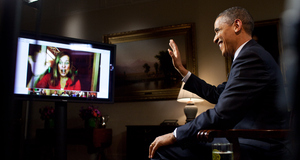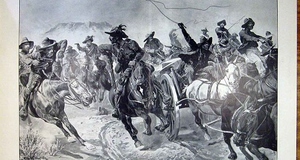Featured Article:Government Public Relations: Public Diplomacy or Propaganda?Comparing the Different Forms of CommunicationSimilarities Between Public Relations and Public DiplomacyGovernment public relations and public diplomacy can be classified under the branch of political communication (Gelders & Ihlen, 2010, p. 61). Political communication can be defined as persuasive communication that seeks to implicitly or explicitly advance political goals. Government public relations falls under political communication because it advances the government's goals. Whether the government's political goal is to inform or persuade, the government will not shy away from communicating with the people. What is more difficult to discern, however, is what implicit political goals (if any) the government is attempting to advance. Public diplomacy can be classified as political communication because it is an ongoing dialogue among political representatives to decide on an amicable solution. Government public relations and public diplomacy each have a long, rich history in classical literature. While Plato’s Gorgias and Aristotle’s The Art of Rhetoric were influential for public relations, Machiavelli’s The Prince and Thucydides History of the Peloponnesian War influenced diplomacy (Signitzer & Wamser, 2005, p. 445). Despite each practice's long history, their formal theoretical academic bases are still fairly new. Considering that both fields are very applied and are practiced by organizations or nation-states, each one is growing together in practice, due in part to globalization and ease of digital communication (L'Etang, 2009, pp. 610-615; Signitzer & Wamser, 2005, pp. 441-445; Wadsworth, 2006, pp. 3-4). According to L'Etang (1996), both diplomats and government public relations practitioners fulfill the functions of intelligence gathering (research, environmental scanning), being representational (rhetoric, advocacy, oratory), dialogic (negotiation, peacemaking) and advisory (counseling) (p. 15). Each can be practiced by an organization or nation-state that are, by their nature, very public bodies. This suggests that there could be a two-way social relationship between the people and the organization (Signitzer & Wamser, 2005, pp. 442). Government public relations and public diplomacy are both responsible for institutional communications with organizations, as well as relations with wider groups and have to be responsive to public opinion and media coverage (L'Etang, 2009, p. 608). Each recognizes that communication is fundamental across social boundaries because each country and government has a unique history shaped by social relationships (L'Etang, 2009, pp. 611-612; Signitzer & Wamser, 2005, p. 435). Academics in each field, however, have been careful to delineate each term from propaganda, as each is susceptible to this vice (L'Etang, 2009, p. 608). Not surprisingly, each field can be found clustered around areas of great social change, as the greatest need for both is found in those areas (L'Etang, 2009, p. 614). Both must be attuned to social change, specifically recognizing that social relationships are always in flux (L'Etang, 2009, p. 617). In these areas of social change, there will be people that do not always agree with these changes (Signitzer & Wamser, 2005, p. 447). Therefore, both government public relations and public diplomacy can identify, explain and negotiate varying opinions on an issue to bring together dissenting factions (Kovacs, 2001, p. 423). Within these social areas, both fields must focus microscopically on their target audience, whether it is a business, NGO or constituent group (L'Etang, 2009, p. 611).In sum, government public relations and public diplomacy have practice aims that are similar. Each attempts to control information coming from various sources in order to setup their media agendas (L'Etang, 2009, p. 611). With the media agenda in place, each can decide how to frame public issues to best meet the end goal of shaping public discourse. When publics are relaying information that is congruent with the strategic communication goals of either public diplomacy or government public relations, the organization gains a significant organizational political advantage (L'Etang, 2009, p. 611). Differences Between Public Diplomacy and Government Public RelationsPublic diplomacy, in contrast to government public relations, is more concerned with governments, as opposed to individual actors (Signitzer & Wamser, 2005, p. 436). As such, public diplomacy can be said to be more congruent with the national interest (Kovacs, 2001, p. 424). For instance, public diplomacy could be characterized as a long-term "hearts and minds" campaign that is aimed at developing emotional bonds with international publics to gain their identification and sympathy (L'Etang, 2009, p. 610). Such is the case with overseas arts tours and exhibitions, as well as the Olympics. These campaigns could possibly span multiple generations, even turning into a social responsibility for the country to capture the diverse emotional and personal experiences of its citizens (L'Etang, 2009, p. 610). Unlike government public relations, public diplomacy can be more high-stakes, as it can be backed up by military force (L'Etang, 2009, p. 610; Signitzer & Wamser, 2005, p. 443). PropagandaAs a term, propaganda undermines professionalism in public relations. Unlike public relations, propaganda has been very quick in adapting to modern communication, which allows it to increase in influence and sophistication (Wadsworth, 2006, p. 8). This is not surprising, as public relations and other forms of strategic communication devise rules of ethical conduct prior to engaging the world with new forms of media. Without ethical rules of conduct, propaganda undercuts decision-making (Gelders & Ihlen, 2010, p. 60). When examining the differences between power-based and value-based PR, propaganda would be considered the former because it undermines ethics to implicitly or explicitly exercise its power towards a specific audience. Much like how PR has power-based and value-based subdivisions, propaganda has three major subdivisions: black propaganda, white propaganda and grey propaganda. Black propaganda "typically has a false source and contains lies and deceptions" (Gelders & Ihlen, 2010, pp. 59-60). White propaganda is just the opposite because it correctly identifies its source and contains accurate information " (Gelders & Ihlen, 2010, p. 60). An example of white propaganda would include Great Britain's peacetime propaganda by the Empire Marketing Board and the British Council after both World Wars. Some of the posters put up by both organizations advocated greater physical activity and the purchase of locally-grown tea (White, L'Etang & Moss, 2009, p. 384). Given the positive connotations with white propaganda, some academics believe that propaganda is necessary for a state to function (Gelders & Ihlen, 2010, pp. 59-60). Many PR practitioners have distanced themselves from the term, instead labeling propaganda persuasion because much of the public may be unfamiliar with the different types of propaganda, much less the positive types (L'Etang, 2002, pp. 47-48; L'Etang, 2009, p. 609). Grey propaganda is between black and white propaganda because, not only is the source incorrectly identified, but the veracity of the information cannot be determined (Gelders & Ihlen, 2010, p. 60). Grey propaganda would likely be used in covert operations, as the information may purposely be missing to prevent the divulgement of sensitive information. An example of propaganda would include terrorism. Terrorism falls under propaganda because it seeks to undermine the political system, crosses party issues, and has objectives that are echoed through the mass media to influence the public (Richards, 2004, pp. 169-170). Terrorism could be considered black, white or grey propaganda. While the word "terrorism" clearly has negative connotations with violence, not all terrorism would be considered black propaganda. On the contrary, some aspects of terrorism could be considered white terrorism because, in order to advance political goals, a terrorist organization must identify themselves correctly as the source, as well as state factual observations in the political systems. Of course, these terrorist organizations can bend the truth by omitting certain facts from a situation, thereby framing the situation in an inaccurate light. Differentiating Government Public Relations from PropagandaDifferentiating between government public relations and propaganda is no easy because not all propaganda is considered negative. In general, academics have preferred to use the term persuasion, as opposed to propaganda (L'Etang, 2002, pp. 47-48). To complicate matters even more, people will confuse the terms because they unwittingly combine public relations, advertising, marketing and even public information (L'Etang, 2009, p. 611). For starters, there are general questions that should be considered, including the goals of the organizations, which method of communication it prefers to use, as well as the types of targeted audiences (Signitzer & Wamser, 2005, pp. 449-457). L'Etang (2002) provides a succinct definition of a profession: A specialized skill and service, an intellectual and practical training, a high degree of professional autonomy, a fiduciary relationship with the client, a sense of collective responsibility to the profession as a whole, an embargo on some methods of attracting business and an occupational organization testing competence, regulating standards and discipline (p. 50). From this definition, it is possible to discern that, public relations as a whole should have ethics. Propaganda, in general, will discount ethics in favor of spinning their "truth" as one-sided. Furthermore, propaganda may not even use training, as it could simply rely on the most-convenient message and thus completely discount ethics during message transmission. An example of this would be the difference between quick and slow media. While quick media (such as the internet) will use media that can be disseminated to a large audience quickly, slow media (such as academic periodicals) is often scrutinized to ensure the accuracy of the information presented (Signitzer & Wamser, 2005, pp. 457-458). It is also possible to discern public relations from propaganda by looking at each from the lens of the realist, rationalist and revolutionist approaches. A realist approach accomplishes tasks based on the belief that the world is pressured by power and greed (L'Etang, 2009, pp. 616-617; Signitzer & Wamser, 2005, p. 455; Walt, 1998, p. 31). Realism, in this case, implies that ethics is discounted in favor of pressuring actors to get their message out as quickly as possible. The rationalist approach believes that building relationships in an international society is best attained through mutual truthfulness and promise-keeping (L'Etang, 2009, pp. 616-617; Signitzer & Wamser, 2005, pp. 455-456). The rationalist approach implies a focus on ethics, as the cornerstone of ethics consists of respect, truth and promises. The revolutionist approach, according to L'Etang (2009) consists of an "international society, made up of individual sovereign states, formed a moral and cultural whole but whose moral authority derived from the will of individual peoples" (pp. 616-617). The revolutionist approach is a tricky definition because, on the one hand, it shows that neither PR nor propaganda may be necessary because the people are already taking care of their own affairs. On the other hand, Signitzer & Wamser (2005) believe that such an approach would see the government as an obstacle (p. 456). This alone could imply that the government could use either public relations or propaganda to pursue their communication needs with the public. Of course, the ultimate end goal of what a government is trying to accomplish will prove to be the defining variable that shows whether the body engages in public relations or public diplomacy. The tough-minded and tender-minded approaches may likewise discern between public relations and propaganda. As these names suggest, the tough-minded approach often employs fast media to aggressively persuade publics to attain short-term policy ends, while the tender- minded approach uses slow media to create "a climate of mutual understanding" (Signitzer & Wamser, 2005, p. 433). From these definitions, tough-minded would be associated more with propaganda because propaganda uses quick, desperate measures to accomplish an immediate policy goal. Since tender-minded uses slow media, it is not surprising that a culture of understanding would take root, as slow media takes the time to ensure fact-checking measures are implemented before any media is disseminated. When this slow media is released, it identifies and clarifies arguments in order for people to make their own judgments.Continued on Next Page » Suggested Reading from Inquiries Journal
Inquiries Journal provides undergraduate and graduate students around the world a platform for the wide dissemination of academic work over a range of core disciplines. Representing the work of students from hundreds of institutions around the globe, Inquiries Journal's large database of academic articles is completely free. Learn more | Blog | Submit Latest in Business & Communications |


















